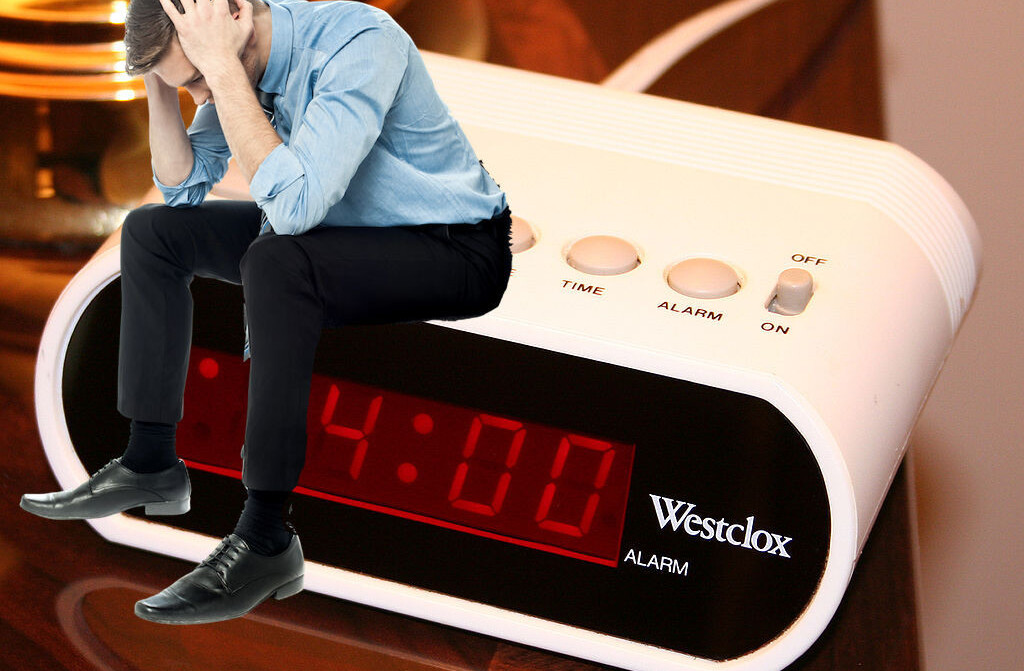
This is the second installment of a new series on The Next Web, in partnership with Steve Kamb at Nerd Fitness. Guides to staying healthy, without giving up your geek lifestyle.
You’re sitting down whilst reading this…right?
Whether you’re at work at your desk, sitting in a coffee shop, lounging on your couch after a long day, or propped up in bed with your iPad, you’re probably seated firmly on your butt while reading The Next Web. And I don’t blame you – sitting has become so ingrained in our culture that most of us (myself included) spend more time sitting in a chair every day than we do sleeping.
If this sounds familiar, you are not alone
Chairs are everywhere, from the seats in our car to the office chair to the restaurant booth where we eat. Sitting seems like the most natural thing in the world, right?
However, what if sitting was actually worse for you than you realized? What if sitting all day resulted in far more health issues than you could possibly imagine? Hell, what if sitting was actually killing you?
Yeah, I know…that sentence sounds like ol’ Steve here has gone off the deep end. Unfortunately, it’s more true than you realize, especially for people in our demographic.
Here’s why you need to get off your ass…and how it could save your life.
The problem with sitting
If you’ve been reading Nerd Fitness for a while, you know that I’m a big fan of the Paleo diet and general paleo lifestyle. After all, we existed as a species for hundreds of thousands of years by living a certain way (hunting, gathering, traveling barefoot), and although technology and advances in science and medicine have certainly helped us live longer, quite a few modern ‘conveniences’ have actually made things harder for us.
Sitting is one of those conveniences that can cause all sorts of damage to our body when done to excess – AKA ‘the typical sedentary American lifestyle’.
I read a great article over on Mark’s Daily Apple that compared ‘sitting’ to today’s modern shoes and sneakers. Sure, your new Nikes might seem comfortable, but they actually weaken all of the muscles and joints in your feet and ankles by doing all of the stabilization work for you – your muscles grow weak, complacent, and bored because they have nothing to do. This is a recipe for injury and disaster.
Your core/hips/groin/legs are no different when it comes to sitting!
When you sit down, your hip flexors (the muscles that work the movements between your pelvis and thigh bones – that crease between your thigh and groin) get tightened and shortened. Meanwhile, your hamstrings and glutes (butt) get all stretched out. Now, obviously your muscles getting stretched and contracted is a part of life – it’s these actions that allow us to do fantastic things, such as ‘moving’.
However, the problems arise when we keep these muscles in this non-standard state for hours at a time.
Think of your muscles as glorified rubber bands – they can stretch and contract as you pull them. Now, take a rubber band and wrap it around a basketball, stretching it to its limit for a few weeks. When you come back and take that rubber band off the ball, it will have almost no elasticity and won’t be able to return to its original shape. Or, it might just snap. Crapola!
If you’ve ever tried to do a heavy leg workout after a day filled with hours of sitting then you know what I’m talking about – you feel like an old man or woman with the flexibility of a steel girder. And that’s just for our hips!
When you factor in slouched-over shoulders, a weakened lower back, a jacked up spine, and that hunchback look that we all adore (not), sitting in an office chair all day pretty much renders our body useless.
Health issues with sitting
Now, in addition to issues relating to flexibility (which is so crucial to having proper form during your exercises), sitting on your butt can cause a litany of other health issues as well.
The most extreme case I’ve heard of recently involved a 20-year old kid who died after getting a blood clot during a marathon video game session – one of the saddest and most tragic stories I’ve ever come across.
Here are some other health issues associated with sitting, as explained in this Art of Manliness article:
“A study found that men who sit for more than six hours of their leisure time each day had a 20% higher mortality rate than those who sat for three hours or less. The epidemiologist who conducted the study, Alpha Patel, concluded that excessive sitting literally shortens a person’s life by several years.
Another study showed that men who sat for 23 or more hours a week had a 64% greater chance of dying from heart disease than those who sat for 11 hours per week or less.”
Even the New York Times has chimed in, explaining that extended bouts of sitting can be a huge pain in the butt for your body. You simply don’t expend much energy sitting down compared to standing up and/or moving around. Sure, it might be just a difference of a dozen calories here and there, but multiplied out over ten hours a day, 365 days a year, and ten+ years…that can equal quite a bit of weight gain.
If you’re looking for something even more extreme, though it’s clearly going for shock value, check out this Sitting is Killing You infographic.
Now, as we all know, correlation does NOT prove causation, so you’d be rightly skeptical in some of the facts listed. For example, those who tend to spend all day sitting compared to those who are more active might have other health issues that can lead to an earlier death.
That being said, no matter which way you look at it…sitting all day is at best ‘not good for you’ and at worst a serious health hazard.
On top of all of the health reasons, there are productivity issues too – I find that sitting while working makes me lazy! I don’t know about you, but when I’m seated in a nice comfy chair, spending hours screwing around on the Internet comes easy. However, when standing up and working, I find it’s much easier to focus and actually get stuff done.
So, let’s do a quick recap. Too much sitting can:
- Mess up your mobility and flexibility.
- Lead to weight gain.
- Weaken your muscles.
- Screw up your posture.
- Lead to a tremendous amount of other health problems.
- Actually kill you.
Ruh roh, Shaggy. Now, let’s see if we can fix this problem.
The Standing Desk
The good ol’ standing desk! If you work at home or in an office where standing is considered acceptable, this is probably your best option.
It promotes healthier behavior, better posture, increases circulation in your legs, will help improve your hip-flex or mobility, and ingrain more of a “I’m active” thought in your brain. Trust me on that one.
So, what’s kind of desk should you be looking for, you ask?
- If you have money to burn, check out GeekDesk.com – it has desks that are like robots, and can transform from a sitting desk to a standing desk at a moment’s notice. Unfortunately, there’s nothing in the return/refund policy to protect you should your desk develop consciousness and attempt to take over the world with the Decepticons – you’ve been warned.
- Check out this hacked desk from IkeaHackers. Back when I had a home, I bought all my furniture at Ikea – easy to assemble, cheap, and you don’t feel bad when it breaks or you move cross country and have to ditch it. A cheap desk + a few modifications = standing desk.
- Play Tetris – if there’s no budget at your office for a new standing desk, why not modify your old desk? Bring in some cinder blocks to prop up the bottom of your desk to a standing desk height? Or, use some milk crates, boxes, stacks of hardcover books, or build a tiny desk (thanks to Mark for the link) to put up on top of your current desk to raise your computer to standing desk height?
- Get REALLY creative – use an ironing board, a dresser or bookshelf. Start doing your work at your kitchen counter, or use a coffee shop’s tall bars on the walls – just aim for a surface height where your arms are at a natural position and you don’t need to hunch over your computer to use it.
Now, the transition to awesomeness won’t be seamless. In fact, things might feel a little funky or painful if you’re used to spending 8+ hours a day parked in your computer chair.
Here’s a report from one dude who switched to a standing desk, when asked if it hurt or bothered him, he said:
“Yes, very much. In fact, the first three days were brutal, so painful I doubted the whole endeavor. By mid-day 2, I had to sit down every hour or so. I was distracted and had a hard time focusing on anything but how much my feet hurt. At night I sat on the couch with my feet elevated. I collapsed into bed totally exhausted. I never appreciated sitting as much as I did the first three days.
Then, on the fourth day, it wasn’t so bad. On day 5, I got lost in work for 2 hours before I thought about the fact that I was on my feet once. Now it’s my new normal.”
Here are a few other things you should keep in mind about making the switch:
- Like the guy said above, it’s going to feel really weird for a while. We are creatures of habit, and our bodies are a result of those habits – a big change like this is going to cause some resistance: your legs will get tired, your feet will hurt, you’ll find yourself constantly wanting to sit down, one leg will get tired and the other won’t, etc. Try this: get yourself a tall stool to sit on when needed and set a clock/timer on your computer, aiming to stand for longer and longer periods each day. For example – 30 minutes today, 35 minutes tomorrow, 40 minutes on Wednesday, and so on. Baby steps, people!
- Pick one that is the right height. You don’t want to bend over at the waist or hunch over to have to use your computer. Set it at a height when you can stand up straight and proud (and full of confidence!), with your shoulder blades pulled back, your arms at a natural height, and your gaze not too far down that it causes discomfort in your neck. If you have an external monitor, I’d recommend setting it high (closer to eye level) so you can simply look straight ahead to see your computer screen rather than down at it.
- Don’t just stand there. Don’t just stand in the same freaking spot for eight hours without moving; that’s almost as bad as sitting and not moving. Shift your weight from one leg to the other, take constant walking breaks (at least every 30 minutes or so) to keep the blood flowing and your legs moving. Personally I haven’t found this to be an issue, as I find myself constantly moving when standing anyways.
But I can’t stand at work
Okay, I hear you.
Maybe you work in Cubicleland, and you at a standing desk would be incredibly awkward. Maybe you don’t have the opportunity to take your laptop to the kitchen and use the counter there. Maybe you’re a traveling salesman and six hours a day in the car isn’t unusual.
If you can’t convince the big boss that standing is a good idea (citing the reasons above), if the Man won’t let you build your own desk, or if your job dictates that you’re in the seated position all day, you’ll have to take a more active role in fixing yourself.
First and foremost, quit your job. Hahaha, I’m just kidding. But seriously, here’s what you should do:
- Start by fixing your posture in your chair – switch to a stool or a chair without a back support so you can work on your posture. Sure, this won’t do much for your hip flexors, butt, and hamstrings getting stretched, but it will help strengthen your lower back and core.“But Steve, this hurts my lower back! I NEED MORE SUPPORT!” No, you need to strengthen your lower back and posterior chain, sucka! It will take time and effort and might even be uncomfortable…but it will be worth the effort.
- Get up every 30 minutes – without fail. Set a time on your computer to force yourself to get up every 30 minutes and go for a walk – go harass your coworkers (I hear they love that) or go chat up that Funke around the water cooler. Just get up and move!
- Be more active – if you spend all day at your computer, try eating your lunch and dinner standing at the counter. If you spend all day at the computer, try playing your Xbox 360 or PS3 standing up. Yup, it’s weird. Yeah, your legs will probably get tired. Get over it! Be more active, even if it means making your nerdy activities a little more active than they need to be. Don’t spend ten hours at your desk only to come home and spend five hours in front of your TV – you’re better than this.
- Train to improve the weak parts – hip raises, squats where you drop below parallel, straight leg deadlifts, regular deadlifts, and lots of hip mobility work will do you well to keep the lower part of your body healthy, flexible, and useful.
How to improve your hip mobility
Above all else, I think the area where us desk jockeys lack the most strength and power is in our hips. And if we’ve learned anything from Happy Gilmore, it’s all in the hips.
Weak hips, glutes, and hamstrings make it incredibly difficult to have perfect form when doing squats and deadlifts – you should be able to squat so that the tops of your thighs are below parallel (or even low enough so that your butt hits the back of your calves). If you can’t squat low enough, I’d bet my life savings that you have weak hip flexors and poor mobility in your hips!
Here’s how to fix that…
Spend at least 5-8 minutes before doing any lower body work working on your mobility with a dynamic warm up – jumping jacks, body weight squats, hip raises, leg swings, side leg swings, and fence step-overs (taught to me by Shawn over at TheFitnessBuster).
Following a routine like this will really activate your hips and allow you to power through your lower body exercises with great form.
Here’s a video if that helps explain it more…
- Do this mobility workout of the day, but don’t say I didn’t warn you (this one too will certainly help). I’ve been sitting a LOT while traveling in Ireland (too much work and lots of time on buses), so doing this mobility workout was incredibly difficult and painful for me when I did it this morning. Do the best you can – don’t hurt yourself, but WORK ON IT.
- Try yoga – does your gym offer yoga classes? Not a bad way to improve your flexibility at all. If your gym doesn’t offer classes, a simple search on YouTube will result in approximately 4.3 bazillion yoga instructional videos.
- Sit less – the less you sit, the less damage you’ll have to undo on your hip mobility. Take frequent breaks at work – go do squats in the bathroom stall, or lunges down your hallway – just be more active.
Sit or stand?
I would love to hear from you on this!
- Do you use a standing desk?
- Have you ever tried one?
- Have you run into resistance from your boss for asking to use one?
- Have a cool way to create a standing desk?
Please let me know your thoughts on standing desks in the comments.
Oh, and for the record, this article was typed while standing at my homemade funky standing desk here in my (dorm) room in Galway.
Image Sources
Get the TNW newsletter
Get the most important tech news in your inbox each week.









